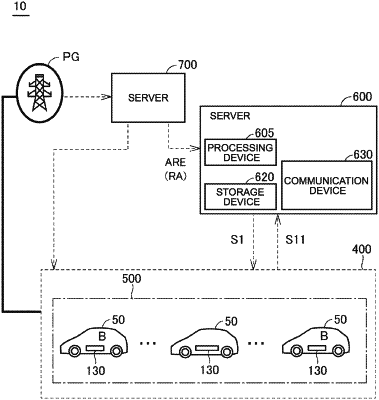| CPC H02J 3/322 (2020.01) [B60L 55/00 (2019.02); H02J 50/10 (2016.02)] | 14 Claims |

|
1. A server that is used by an aggregator to manage a plurality of vehicles each configured to be able to participate in a demand response (DR) for adjusting a power demand-supply balance in a power system,
the server comprising:
a communication device configured to be able to transmit a DR signal that requests participation in the DR to each of the vehicles; and
a processing device that selects a target vehicle, to which the DR signal is to be transmitted by the communication device, from among the vehicles in accordance with a priority degree for participation in the DR, wherein:
a first vehicle among the vehicles is configured to be able to participate in the DR by executing first power transmission to transmit power with a power stand that is external to the first vehicle through a power cable for the power stand;
a second vehicle among the vehicles is configured to be able to participate in the DR by executing second power transmission to transmit power in a non-contact manner with power equipment that is external to the second vehicle while the second vehicle is stationary;
a third vehicle among the vehicles is configured to be able to participate in the DR by executing third power transmission to transmit power in a non-contact manner with power equipment that is external to the third vehicle while the third vehicle is traveling; and
the processing device is configured to set the priority degree of the first vehicle to be higher than the priority degree of the second vehicle, and to set the priority degree of the second vehicle to be higher than the priority degree of the third vehicle.
|